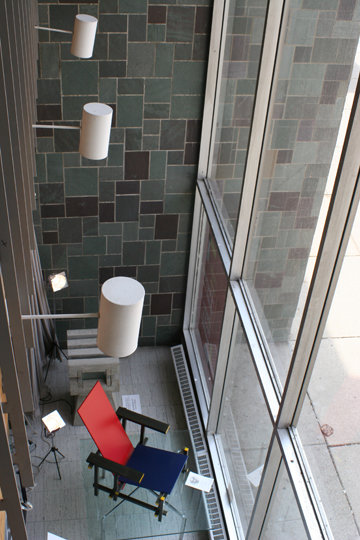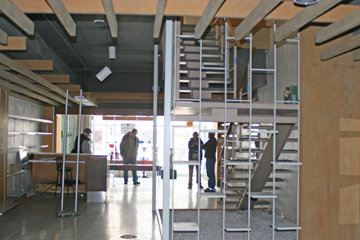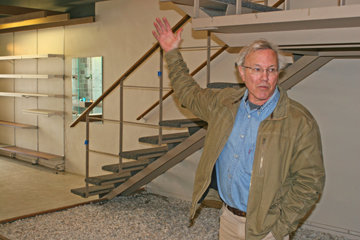
Tucked into the mishmash of storefronts a block from the state Capitol in Lansing is a jewel of mid-20th century design.
The clean lines and glassy serenity of the former Liebermann’s Department Store at 113 Washington Ave., known to architecture lovers the world over, have not melted into postmodern mediocrity.
Last Friday, owner Tom Price ushered several members of the Historical Society of Greater Lansing into the almost perfectly preserved 1965 space. That’s when the turn-of-the-century building acquired its sleek appearance.
The Historical Society is looking into using the building as exhibit and office space, but there is no game plan yet. Price is enthusiastic about the idea, but grants will have to be written and financial partners and tenants will have to be found.
Since 2005, Price has been holding out for a buyer who will take proper care of the only retail store in the country designed by modernist architect and designer George Nelson.
“We could have sold it many times to a restaurant that would probably be out of business in a year, and that isn’t what we wanted to see happen to it,” Price said.

Most recently, Price turned down a brewpub that wanted to cut holes in the ceiling for holding tanks.
As they nosed around the interior, the frequent joke among these graying, middle-aged men was, “call Jack White.”
Yes, that Jack White.
Nelson is getting a new round of name checks in the national press because White, half of the White Stripes and a connoisseur of modern design, bought a George Nelson house in Kalamazoo last year.
White takes his role as custodian of the house seriously. He paid $510,000, or $60,000 more than the asking price, and plans to use it as a writing retreat.
“I’m a believer that nobody owns anything,” he said in a New Yorker profile this month. “A George Nelson house, there’s not too many of those.”
There are even fewer George Nelson retail stores — just one, in fact.
Liebermann’s closed in 1990. The Michigania gift shop and the Lansing Art Gallery occupied the space after that, but almost everything that made the store’s design unique is still here.
Price’s mother, Liebermann’s owner and classy Lansing retail queen Betty Price, sought out Nelson to redesign Liebermann’s after reading his 1945 book, “Tomorrow’s House.”
The design is a chamber concerto in glass and wood, influenced by Japanese design principles. The storefront is open and airy, yet set apart. Four 22-foot-high glass panels are set back from the neighbors by colorful slate walls.
Inside, a hovering staircase leads to the mezzanine. The steps float over a bed of white stones where a Japanese rock garden used to be.
The walls are still lined with Nelson’s famous (to connoisseurs) Comprehensive Storage System shelves, cantilevered, adjustable tracks designed for another world-renowned modernist firm, Herman Miller furniture of Zeeland.
The shelves, by themselves, sell for thousands on Internet auction sites.
Overhead, instead of a drop ceiling, Nelson laid out a delicate latticework of light wood beams, still in excellent shape.
Historical Society members Peter Hafner and Zig Olds couldn’t stop opening and closing the shelves and basking in their embedded lighting.
“So this is all original and nothing’s been taken out?” Hafner asked.
“Yeah,” Price said. “There’s more shelving downstairs.”
Hafner grew up in the Lansing area and came to Liebermann’s with his parents. He hasn’t stepped inside for decades.
“It’s a gorgeous space,” he said. “A lot of good memories here.”
Price stocked the shelves with highend stuff like Swedish crystal and Noguchi lamps, but you could also get a wooden bowl, paper lantern or glass vase for under 10 bucks. Kids, Hafner among them, found games and toys for less than that.
Hafner still has stainless steel serving dishes he bought at Liebermann’s as an adult.
The group scrutinized the floating stairs Betty Price climbed dozens of times a day, an exercise that may have contributed to her longevity. She died in 2013 at 99.
“Everyone who came in that door was treated equally,” Hafner said. “She’d always remember your name, what kind of things you liked, made you feel special.”
Hafner said he’d “love to see this space respected.”
Tom Price said he is trying, but the clock is ticking.
“It needs constant maintenance,” Price said.
In 2011, Price sold his mother’s Lansing home, designed by Kenneth Black, and used some of the proceeds to tear the roof from the former Liebermann’s down to the deck, stripping away layers going back to 1900 and adding a new membrane and insulation.
Last year, some stucco fell off the front of the building because of improper drainage. The flaw could have been the fault of the builder or “it could have been the designer,” Price said, diplomatically omitting Nelson’s name.
“For 50 years, the water was rotting the plywood holding the stucco in place,” Price said. The problem was fixed, at a cost of about $10,000.
Price has contacted the George Nelson Foundation in New York and Herman Miller Inc., asking for support to keep the building maintained.
“Those are avenues we need to pursue if it’s going to remain,” Price said. “If the Historical Society could possibly swing it, it would be a great way to preserve the building and use it in a way that’s close to its present form.”
Bill Castanier, president of the Historical Society (and City Pulse contributing writer) called it a “real opportunity.”
“It’s a perfect location,” Castanier said. “This place really has a historical pedigree.”
The Historical Society is putting together an application for a grant to make a business plan and an engineering study.
“And we have to hurry,” Castanier said. “Tom isn’t going to wait forever.”
“We paid the winter taxes,” Price said with a grin.

Castanier said he expects the Historical Society would have to pay in the $400,000 range to purchase the building — which will take a lot of fundraising.
Last year, when Price was dealing with the stucco collapse, he got one of those signals life seems to send just when they are needed. Standing in front of the store, Price spotted Robert Bell, a Liebermann’s employee for 42 years who visits the nearby Peanut Shop each week.
“Tommy, I know you wanted to save the building as long as your mother was alive,” Bell told Price. “You can sell the building.”
Bell died last May.
“Robert giving me dispensation to sell it meant a lot,” Price said. “His daughters, his mother, his whole family worked here.”
The story had the intended effect.
“Call Jack White,” came a voice from the back of the store.
Support City Pulse - Donate Today!
Comments
No comments on this item Please log in to comment by clicking here